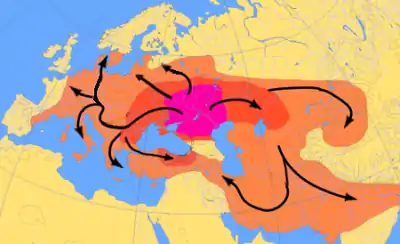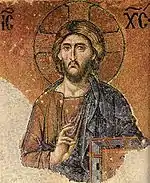آلبانیاییها
آلبانیاییها (به آلبانیایی: Shqiptarët) یکی از گروههای نژادی شبه جزیره بالکان هستند که بیشترشان در آلبانی و کوزوو زندگی میکنند. آنها به زبان آلبانیایی سخن میگویند. بیشتر آنها در کوزوو و آلبانی هستند و بقیه نیز در ایتالیا، مقدونیه، مونتنگرو و یونان مستقر هستند. بیشینه آنها مسلمانند.[38]
 | |
| کل جمعیت | |
|---|---|
| 7.5– 12.2 million[note 1] | |
| مناطق با جمعیت چشمگیر | |
| Rest of Balkans: | ca. 1.4 million– 4.2 million |
| 500,000-5,000,000۲[3][4][5][6][7][8] | |
| ۵۰۹٬۰۸3 (2002)[9] | |
| 280,000 to 600,000 (Includes dual citizens, temporary migrants, and undocumented)[10][11][12] | |
| ۳۰٬۴۳۹[13] | |
| ۱۷٬۵۱3 (2011)[14] | |
| ۱۰٬۰۰۰[15] | |
| ۵٬۸۰۹[16] | |
| ۴٬۰۲۰[17] | |
| Rest of Europe: | ca. 1,513,600 |
| 800,000۱[18][19][20] | |
| ۳۰۰٬۰۰۰[21] | |
| ۲۰۰٬۰۰۰[22][23] | |
| ۵۴٬۰۰۰[24] | |
| ۳۰٬۰۰۰[25] | |
| ۲۸٬۲۱۲[26] | |
| ۲۰٬۰۰۰[27] | |
| ۵٬۰۰۰–۲۰٬۰۰۰ | |
| ۱۰٬۰۰۰ | |
| ۸٬۲۲۳[28] | |
| ۸٬۲۱۴[29] | |
| ۵٬۶۰۰–۳۰٬۰۰۰[30][31] | |
| ۵٬۰۰۰[32] | |
| Rest of World: | ca. 250.000 |
| ۱۹۳٬۸۱۳[33] | |
| ۲۸٬۲۷۰[34] | |
| ۱۸٬۰۰۰[35] | |
| ۱۱٬۳۱۵[36] | |
| زبانها | |
| Albanian (Gheg and Tosk Dialects) | |
| دین | |
اسلام | |
۱ 502,546 Albanian citizens, an additional 43,751 Kosovo Albanians and 260,000 Arbëreshë people[18][19][37] ۲ Albanians are not recognized as a minority in Turkey. However approximately 500,000 people are reported to profess an Albanian identity. With those that have only partial Albanian ancestry and the ترکسازی ones the number is about 1,300,000- 5,000,000 most of whom do not speak Albanian.[4] | |
نگارخانه
پانویس
- The totals are obtained as the sum of the referenced populations (lowest and highest figures) below in the infobox.
- "Main Results of Population and Housing Census 2011". INSTAT. Archived from the original on 3 August 2017. Retrieved 24 December 2013.
- "2011 Census: Population and Housing Census in Kosovo Preliminary Results" (PDF). June 2011. Archived from the original (PDF) on 19 January 2012.
The preliminary results of the 2011 census in the Republic of Kosovo show the national population at 1,733,872 but the census was boycotted in North Kosovo and this figure does not include the entire population of Kosovo. The 2011 census revealed a figure of 1,616,869 people declaring as Albanians. - Marta Petricioli (2008). L'Europe Méditerranéenne. Peter Lang. p. 46. ISBN 978-90-5201-354-1. Retrieved 4 November 2015.
- Christopher Deliso (2007). The Coming Balkan Caliphate: The Threat of Radical Islam to Europe and the West. Greenwood Publishing Group. p. 38. ISBN 978-0-275-99525-6. Retrieved 4 November 2015.
- "Türkiyedeki Kürtlerin Sayısı!" (به Turkish). Milliyet. 2008. Retrieved 2008-06-07.
- "Albanians in Turkey celebrate their cultural heritage". Todayszaman.com. 21 August 2011. Retrieved 4 November 2015.
- Robert A. Saunders (2011). Ethnopolitics in Cyberspace: The Internet, Minority Nationalism, and the Web of Identity. Lexington Books. p. 98. ISBN 978-0-7391-4194-6.
- Cuneyt Yenigun. "GCC Model: Conflict Management for the "Greater Albania"" (PDF). Süleyman Demirel University:Faculty of Arts and Sciences Journal of Social Sciences. Archived from the original (PDF) on 27 September 2015. Retrieved 4 November 2015.
- "2002 Macedonian Census" (PDF). Archived (PDF) from the original on 22 September 2010. Retrieved 22 September 2010.
- Managing Migration: The Promise of Cooperation. By Philip L. Martin, Susan Forbes Martin, Patrick Weil
- "Announcement of the demographic and social characteristics of the Resident Population of Greece according to the 2011 Population - Housing Census" (PDF). Greek National Statistics Agency. 23 August 2013. Retrieved 3 June 2014. Unknown parameter
|trans_title=ignored (help) - Rainer Bauböck; Eva Ersbøll; Kees Groenendijk; Harald Waldrauch (2006). Acquisition and Loss of Nationality: Comparative Analyses - Policies and Trends in 15 European Countries. Amsterdam University Press. p. 416. ISBN 978-90-5356-920-7. Retrieved 4 November 2015.
approximately 200,000 of these immigrants have been granted the status of homogeneis
- "Official Results of Monenegrin Census 2011" (PDF). Retrieved 24 December 2013.
- "Population by Ethnicity, by Towns/Municipalities, 2011 Census". Zagreb: Croatian Bureau of Statistics. December 2012.
- "Date demografice" (به Romanian). Archived from the original on 11 August 2010. Retrieved 18 August 2010.
- "Serbia Census 2011" (PDF). Retrieved 13 December 2015.
- "Slovenia: Languages (Immigrant Languages)".
- "Kosovari in Italia".
- Albanian, Arbëreshë - A language of Italy - Ethnic population: 260,000 (Stephens 1976).
- "Cittadini non comunitari regolarmente presenti". istat.it. Retrieved 3 October 2014.
- هانس پیتر بارتلز: Deutscher Bundestag - 16. Wahlperiode - 166. Sitzung. Berlin, Donnerstag, den 5. Juni 2008 بایگانیشده در ۲۰۱۳-۰۱-۰۳ توسط Wayback Machine
- "Die Albaner in der Schweiz: Geschichtliches – Albaner in der Schweiz seit 1431" (PDF). Archived from the original (PDF) on 7 July 2011. Retrieved 22 September 2010.
- "Im Namen aller Albaner eine Moschee?". Infowilplus.ch. 2007-05-25. Archived from the original on 10 December 2012. Retrieved 22 September 2010.
- "Total Population of Albanians in the Sweden".
- Bennetto, Jason (2002-11-25). "Total Population of Albanians in the United Kingdom". London: Independent.co.uk. Retrieved 22 September 2010.
- "Statistik Austria". Statistik.at. Archived from the original on 13 November 2010. Retrieved 24 December 2013.
- "Étrangers - Immigrés: Publications et statistiques pour la France ou les régions" (به فرانسوی). Insee.fr. Retrieved 4 November 2015.
- "National statistics of Denmark". Dst.dk. Archived from the original on 26 September 2010. Retrieved 22 September 2010.
- "Demographics of Finland".
- "Population par nationalité, sexe, groupe et classe d'âges au 1er janvier 2010" (به French). Archived from the original on 22 December 2011. Retrieved 12 January 2012.
- "Anderlecht, Molenbeek, Schaarbeek: repères du crime à Bruxelles". cafebabel.com. Archived from the original on 26 December 2011. Retrieved 12 January 2012.
- Olson, James S. , An Ethnohistorical Dictionary of the Russian and Soviet Empires. (Westport: Greenwood Press, 1994) p. 28–29
- "Total ancestry categories tallied for people with one or more ancestry categories reported 2010 American Community Survey 1-Year Estimates". United States Census Bureau. Retrieved 30 November 2012.
- "Ethnic Origin (264), Single and Multiple Ethnic Origin Responses (3), Generation Status (4), Age Groups (10) and Sex (3) for the Population in Private Households of Canada, Provinces, Territories, Census Metropolitan Areas and Census Agglomerations, 2011 National Household Survey".
- "Egypt: Languages (Immigrant Languages)".
- "20680-Ancestry (full classification list) by Sex - Australia" (Microsoft Excel download). 2006 Census. Australian Bureau of Statistics. Retrieved 2 June 2008. Total responses: 25,451,383 for total count of persons: 19,855,288.
- Ethnobotany in the New Europe: People, Health and Wild Plant Resources, vol. 14, Manuel Pardo de Santayana, Andrea Pieroni, Rajindra K. Puri, Berghahn Books, 2010, p. 18.
- CIA World Factbook 2010
This article is issued from Wikipedia. The text is licensed under Creative Commons - Attribution - Sharealike. Additional terms may apply for the media files.
.png.webp)




